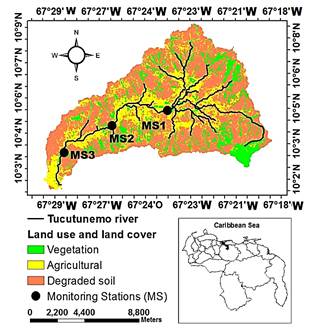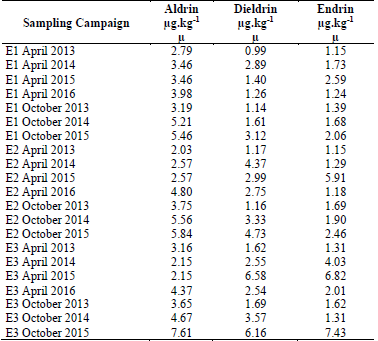1. Introduction
The study presents the temporal variation of the Organochloride Pesticides (OCPs) measured in a river influenced by the agricultural activities developed in a tropical country. Although the use of these pesticides has been banned in several countries, the results show that their metabolites continue to be found in environmental samples due to their long half-life. The OCPs are synthetic pesticides that belong to the group of chlorinated hydrocarbon derivatives [1]. Some of these are considered persistent organic pollutants (POPs) that resist degradation and thus remain in the environment for years [2]. In human fats, the OCP’s accumulation levels reached in proofs done on humans corresponded to the p.p’-DDE by comparing with other DDTs [3]. Regarding to fish fats, it has been found a bioaccumulation factor, which can vary in the order to 104 to 105 in most of water bodies [3].
At the end of the 20th century, most of the studies were developed to characterize the concentration of DDT and its congeners on soils and sediments in agricultural land and rivers [4-10]. In these, the forms of DDTs sampled were p.p’-DDT and o.p’-DDT, the congeners mainly sampled were p.p’-DDD and p.p’-DDE. The measured concentrations of DDTs have commonly varied between 10-1-101 µg.kg-1 dry weight for soils and sediments and 10-2-10-1 µg.L-1 for water [4-10] (Table 1). From the beginning of 21th century to the present, the studies have extended the variety of OCPs examined in both, soils and water [11-34]. From 24 studies, 63% were made in soils and sediments (10-1-101 µg.kg-1 dry weight), 29% in water and sediments (10-2-10-1 µg.L-1, 10-1-101 µg.kg-1 dry weight), 8% in water (10-2-101 µg.L-1) [11-34] (Table 1).
Table 1 Comparison of organochlorine pesticides characteristics in water and sediments
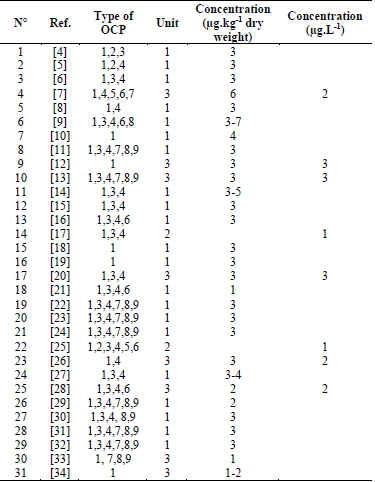
Type of OCPs: 1) p.p’-DDT, 2) o.p’-DDD, 3) p.p’-DDE, 4) o.p’-DDE, 5) o.p’-DDE, 6) o.p’-DDT, 7) Aldrin, 8) Dieldrin, 9) Endrin. B) Study unit: 1) Sediments, 2) Water, 3) Sediment and Water. C) Sediment concentration (µg.kg-1 dry weight): 1) 10-3-10-2, 2) 10-2-10-1, 3) 10-1-101, 4) 101-102, 5) 102-103, 6) 102-105, 7) 105-107. D) Water concentration (µg.L-1): 1) 10-7-10-2, 2) 10-2-10-1, 3) 10-1-101, 4) 101-102, 5) 102-103, 6) 102-105.
Source: The Authors
In Venezuela, [35] characterized OCPs and physicochemical parameters in water and sediments of the Tucutunemo river. In water, total concentrations of OCPs varied in the order of 10-2 µg.L-1, below the regulation of the Bolivarian Republic of Venezuela. In the sediments, the total concentrations of OCPs ranged in the order of 101 µg.kg-1. This investigation presents the results of OCPs measured in water and sediments in the Tucutunemo river during the dry and rainy seasons for the period 2013-2016. The purpose implies to determine the levels of the concentrations of the OCPs in water and sediments of rivers for contributing to establish thresholds of concentrations that allow protecting the biota in soils and waters in tropical rivers.
2. Study area
The study area is the Tucutunemo river basin located in the central region of Venezuela (Fig. 1). The water and sediment monitoring stations on the river are three located in the zones of basin (Fig. 1): E1: 67°23'26.485"W and 10°4'46.74"N, E2: 67°26'1.54"W and 10°4'25.33"N, E3: 67°27'45.907"W and 10°3'23.173"N. The land use and land cover detected are (Fig. 1): 1) vegetation (18.92 km2, 16%, 0.01), 2) agricultural (30.08 km2, 25%, 0.13), 3) degraded soil (69.95 km2, 59%, 0.28).
3. Methods
In this study, the method applied to analyze the temporal variation of organochlorine pesticides in the Tucutunemo river includes the following stages:
a) Selection of monitoring stations of OCPs: three water and sediment monitoring stations were selected from upstream of the basin to the 15000 m (E1), mean 10000 m (E2) and low 5000 m regarding to the outlet of basin (Fig. 1).
b) Collection of samples of OCPs: the water samples were collected in the middle of each cross section. The soil samples were captured from a layer of 10 cm in the river banks. In both cases, the samples were collected with a frequency of every six months, in two seasons: dry (April) and rainy (October) during the period 2013-2016.
c) Analytical determination in the laboratory of OCPs: For the determination and quantification of analytes, a gas chromatograph with electronic capture detector, brand SHIMADZU, model GC-14B, was used in the laboratory of Environment Ministry. The OCPs involved are eight: p.p'-DDT (1,1,1-Trichloro-2,2-bis(4-chlorophenyl)ethane), o.p'-DDT (1,1,1-Trichloro-2-(2-chlorophenyl)-2-(4-chlorophenyl)ethane), p.p'-DDD (1,1,1-Trichloro-2-(2-chlorophenyl)-2-(4-chlorophenyl)ethane), p.p'-DDE (2,2-Bis(4-chlorophenyl)-1,1-dichloroethylene), o.p'-DDE (2-(2-Chlorophenyl)-2-(4-chlorophenyl)-1,1-dichloroethene), Aldrin (1,2,3,4,10,10-hexacloro-1,2,4α,5,8,8α-hexahidro-1,4-endo,exo-5,8-dimetanonaftalina), Dieldrin (1,2,3,4,10,10-hexacloro-6,7-epoxi-1,4,4α,5,6,7,8,8α-octahidro-1,4-endo,exo-5,8-dimetanonaftalina) and Endrin (C12H8Cl6O). The limits of detection of the OCPs dissolved in water were of 0.001 µg.L-1 and sorbed in sediments was of 0.01 µg.kg-1 [36].
d) Analysis of variation of OCPs: the results of variation of OCPs were compared with other studies indicated in Table 1. The studies were selected in correspondence with the characterization of the OCPs dissolved in surface waters and sorbed on sediments from rivers during the period 1980-2020. The selected period began a decade above in which a group of OCPs were banned in the Stockholm Convention on Persistent Organic Pollutants in the early 1970s, including DDT and its metabolites likewise DRINs (Aldrin, Dieldrin amd Endrin) [37-39]. The ban of OCPs was due to its harmful effects, including high environmental persistence, chemical stability, high lipophilicity, long-range transportation, chronic and acute toxicities, and bioaccumulation [37-39]. The OCP’s statistical analysis consisted of estimating parameters such as mean and standard deviation for dry and rainy seasons during the period 2013-2016 (Tables 2 - 5).
4. Results
As a sample, the mean concentrations in the water of the Tucutunemo river for p.p’-DDT varied between 0.002 and 0.009 µg.L-1 in dry season while these varied between 0.009 and 0.016 µg.L-1 in rainy season (Table 2). The mean concentrations in water of the Tucutunemo river for Aldrin varied between 0.0023 and 0.034 µg.L-1 in dry season while these varied between 0.004 and 0.013 µg.L-1 in rainy season (Table 3). The mean concentrations in sediments of Tucutunemo riverbed for p.p’-DDT varied between 0.77 and 4.28 µg.kg-1 in dry season while these varied between 1.87 and 7.66 µg.kg-1 in rainy season (Table 4). The mean concentrations in sediments for Aldrin varied between 2.03 and 4.8 µg.kg-1 in dry season while these varied between 3.19 and 7.61 µg.kg-1 in rainy season (Table 5).
Table 2 Statistical parameters of dichlorodiphenyltrichloroethane (DDT) concentrations in terms of its isomers and congeners in three water-sampling stations of the Tucutunemo river, Venezuela, during the period 2013-2016.
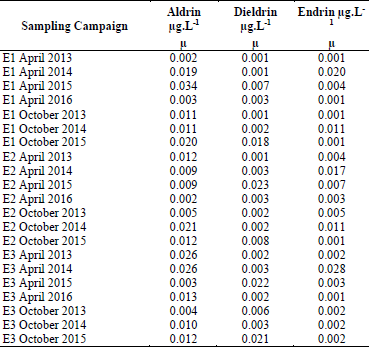
Source: The Authors
Table 3 The concentrations of DRINs in three water-sampling stations of the Tucutunemo River, Venezuela, during the period 2013-2016.
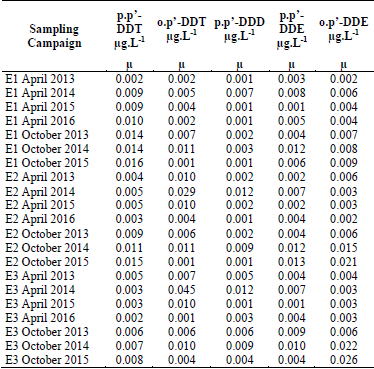
Source: The Authors
Table 4 Concentrations of dichlorodiphenyltrichloroethanes (DDTs) in terms of its isomers and congeners in three sediment-sampling stations of the Tucutunemo river, Venezuela, during the period 2013-2016.
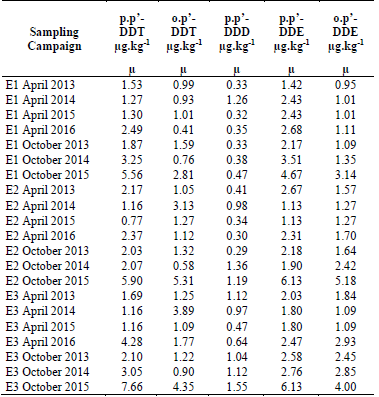
Source: The Authors
5. Discussion
5.1 Variation analysis of OCPs dissolved in waters of a tropical river with respect other studies.
By comparing the concentrations of the DDTs found in the water of the Tucutunemo river (Table 2), which varied between 10-2 - and 101 µg.L-1 with those found in six studies (Table 1), ranging between 10-2 - 101 µg.L-1, it was found that the variation of the DDTs was not significant. The highest concentrations obtained in the water of the Tucutunemo river corresponded to p.p’- DDE by comparing with other DDTs (Table 2). The origin of p.p’-DDE in the water of the Tucutunemo river could be an anaerobic o aerobic biodegradation of p.p’-DDT or a mobility in the water-sediment interface from the sediments in the riverbed to water by a desorption process.
The concentrations of the DRINs obtained in the water of the Tucutunemo river resulted ranging from 10-2 to 101 µg.L-1, as it is shown in the Table 3, which were found lower in an order of 10 times than those shown in Table 1, which varied between 10-1 and 101 µg.L-1. The concentrations of the DRINs in the Tucutunemo river varied from the dry to the rainy seasons in the order of 10-1. The highest values corresponded to Aldrin by comparing with other OCPs.
The technical-grade DDT is a mixture of three chemical compounds: p.p'-DDT (65-85%), o.p'-DDT (15-21%) and of very small amounts of o.o'-DDT (<4%) [37]. DDT can be biodegraded under aerobic and anaerobic conditions [37]. In vitro studies suggest that the ring excision stage of DDT requires the enzyme oxygenase to transform to DDE in the former stage under aerobic conditions [40]. The anaerobic conditions optimize the decomposition of DDT by catalysis performed due to the reductive dehalogenase enzyme to produce DDD [41].
The mechanism of reductive dehalogenation is hydrogenolysis, also known as hydrodehalogenation, which involves the replacement of a halogen atom by a hydrogen atom [41]. DDD has been used as a pesticide, but its use has been more limited compared to DDT [37]. The main forms of organochlorine pesticides such as DDT and DDD are being applied in the soils of agricultural plots of the Tucutunemo river basin.
Once these pesticides are released into the air or onto crops, they can be subjected to three processes [41]: 1) transport, 2) transformation or 3) accumulation.
The deposition process can transport the pesticide from the air to the ground [37, 41]. The pesticide may be sorbed onto soil particles and retained some time. Once the soil particle is saturated with the pesticide, the excess can be returned by dissolution to the water that drains over the agricultural fields and transported to the water bodies as rivers and water reservoir, through a process known as desorption [41].
In the agricultural field of the Tucutunemo river basin, the sediment transport process has its origin in the water erosion. The terrain slope in the agricultural plots is less than 15% (Fig. 1). The water provided by the irrigation in the agricultural plots drains to the Tucutunemo riverin a segment with a slope of the land from 6% upstream to 3% downstream close the outlet of the basin (Fig. 1). In the soil, microorganisms biodegrade DDT to its isomers such as DDE and DDD under anaerobic conditions [40]. Both DDT as its isomers are being transported to the Tucutunemo river dissolved in water or adsorbed in sediments. The Aldrin applied to agricultural plots can be subjected to chemical and biochemical processes: retardation and biodegradation, respectively. In the case of biodegradation, once the Aldrin has been desorbed from the agricultural soil towards the solution-mass and it is in an aqueous phase, the bioavailability of Aldrin is increased and a biochemical transformation can occur. It might be carried out by the microorganisms contained in the agricultural soil, converting Aldrin to Dieldrin [41]; according to which the oxigenase enzyme influences the metabolism by catalyzing the insertion of an oxygen atom present between doubly bound carbon atoms forming a triangular arrangement, known as epoxide [38,41]. This biodegradation could lead to a process of attenuation of Aldrin in the agricultural soils of the Tucutunemo river basin
The transport of the OCPs and its isomers in the Tucutunemo river has a trend to occur under a condition of steady flow. In the steady flow [42], the properties of the fluid do not depend on time. In the Tucutunemo river, the flow rate took values in the order of 10-2 m3 s-1 between dry and rainy seasons for 2015 [35]. These three characteristics represented by two concentration gradients are an indication that the primary OCPs such as: p.p'-DDT, Aldrin, Dieldrin, and Endrin are being applied to agricultural soils permanently in the settlement of the Tucutunemo river basin.
5.2 Variation analysis of OCPs sorbed on sediments of a tropical river with respect other studies.
By comparing concentrations of DDTs sorbed in sediments of the Tucutunemo riverbed (Table 4), which varied between 10-1 - 101 µg.kg-1 with those reported in 20 studies presented in the Table 1, ranging from 10-1 to 101 µg.kg-1, it was found that the variation was not significant. The concentrations of DDTs in sediments were higher in the dry season than rainy season in an order from 2 to 6 times. The highest values were found for p.p’-DDT and p.p’-DDE (Table 4).
With respect to the concentrations of DRINs sorbed on sediments of the Tucutunemo river, these varied between 10-1 and 102 µg.kg-1 (Table 5). By comparing these results with nine studies shown in Table 1, in which, the DRINs sorbed on sediments varied from 10-1 to 101 µg.kg-1, it was found that the riverbed contains concentrations higher than those shown in Table 1 in an order of 102 times. The concentrations of DRINs were higher in the dry season than rainy season in the order of 10 times. The highest values were found for Aldrin with regard to the remaining DRINs.
With regard to DRINs biodegradation, Aldrin is biodegraded to Dieldrin; due to influence of the oxygenase enzyme on microbial metabolism by catalyzing the insertion of an oxygen atom present between doubly bound carbon atoms forming a triangular arrangement, known as epoxide [39,40]. Endrin can degrade when exposed to high temperatures or light, forming mainly ketone and Endrin aldehyde and has low water solubility [41].
Although biodegradation and sorption-desorption processes might be occurring in the agricultural soils of the Tucutunemo river basin; the primary pollutants are not being attenuated, which means that there is a permanent and current use of the OCPs in the agricultural soils of the Tucutunemo river basin.
In the agricultural soils might be occurring chemical and biochemical processes such as retardation and biodegradation. The former would correspond to sorption / desorption processes, while in the latter, the main strategies used by microorganisms to feed OCPs would consist of the following metabolic pathways [41]: oxidation as epoxidation, reduction transformations as reductive dehalogenation and hydrolytic transformations such as dehydrohalogenation.
In agricultural soils, the main transport of OCPs occurs by water erosion and runoff. In the river, the transport nature of OCPs in waters and sediments can be given by processes of the type: advective, molecular diffusion, turbulent diffusion, and hydrological cycle as rainfall-runoff [41].
5.3 Variation analysis of OCPs dissolved in waters and sorbed on sediments of a tropical river with respect legislation.
In Venezuela, Sanitary Standard (1998) [43] regulates the maximum contaminant level in drinking water for OCPs as follows: DDT and its metabolites (0.2 µg.L-1), Aldrin (0.03 µg.L-1) and Dieldrin (0.03 µg.L-1). By comparing the average OCPs measured in the water samples of the Tucutunemo river with legislation, it was found that the observed values are slightly lower than the maximum level for the OCPs established in the legislation.
With respect to the maximum level of OCPs in soil, the Department of toxic substances control of California Environmental Protection Agency in 2010 established the soil screening numbers (mg.kg-1 soil) for nonvolatile chemicals based on total exposure to contaminated soil: inhalation, ingestion and dermal absorption. By comparing the mean values of OCPs determined in sediments of river with environmental regulation of California Environmental Protection Agency [44]., it was found that the observed values were lower than the maximum contaminant level for the OCPs established by the California human health screening levels, as a reference.
In general, the banned OCPs are being applied in many countries despite the prohibition of the Stockholm Convention [45]. In the agricultural fields of Tucutunemo river basin, the dose of applied OCPs would lead to the potential use in water and soils, implying that the management of the basin by the community of farmers is guaranteeing the protection of the means of soil, water and biota.
6. Conclusions
This study has contributed to increase the knowledge about the characterization of OCPs in water and sediments in a tropical river. The characterization of OCPs in water and sediments resulted similar to those found on a sample of 31 studies, 68% of studies in sediments and soils, 26% studies in water and sediments at the same monitoring campaigns, and 6 % studies in water.
The organochlorine pesticides that include DDTs and DRINs are currently being applied to control insects in agricultural crops of a tropical basin. The temporal variation analysis of OCPs in water and sediments of river during the period 2013-2016 reveals that three processes could be occurring: 1) accumulation, 2) transformation (biodegradation) and 3) transport (agricultural runoff, diffusion -advection and sorption- desorption).
When comparing with the environmental regulation to control of drinking water and OCPs in soil, it was found that observed values of OCPs in water and sediments are lower than the environmental regulation thresholds.













